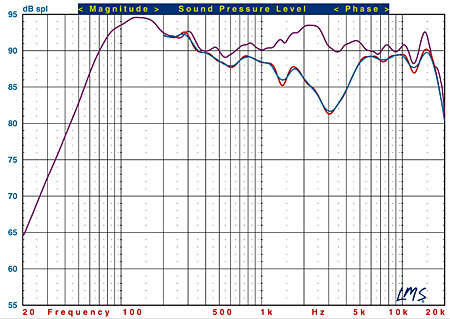Triad InRoom Platinum Speaker System Measurements
No grilles were provided with the InRoom Platinum speakers, so all measurements shown are with the drivers unobstructed.
The sealed cabinet Platinum LCR is tuned to approximately 51Hz, with a minimum impedance of 3.18Ω at 284Hz. I would rate the speaker's nominal impedance at 4Ω. The speaker's sensitivity is approximately 92dB/2.83V/m, a bit less than specified. It should be a moderately easy load for any competent amplifier.
The horizontal front response of the Platinum LCR is shown in Fig.1 (violet). This is the pseudo-anechoic response averaged over a 30° forward horizontal angle, taken at tweeter height, combined with the nearfield responses of the woofers and port.

Fig.1: Platinum LCR, pseudo-anechoic response at 45° (red) and 60° (blue) off-axis in the horizontal plane.
This ±15° averaged front horizontal response is very linear. Apart from some small ripples in the response, which should not be audible, the only significant characteristic is a small, uniform emphasis, without significant peaks, across the upper midrange and treble relative to the 300Hz-600Hz region. The horizontal off-axis response tracks the on-axis result fairly closely up to 2kHz, but above that the wide off-axis response falls off significantly, likely due to the inherent characteristics of the horn tweeter. The effective lower limit of the bass is about 49Hz (-10dB). The speaker is clearly designed for use with a subwoofer.
Fig.2 shows the same averaged horizontal front response (purple), this time overlaid with the vertical responses taken at +15° (red) and –15° (blue). These curves suggest that the vertical position of your ear should be as close to the center of the tweeter as possible to avoid a significant suckout centered at about 2kHz both above and below the horn.

Fig.2: Platinum LCR, pseudo-anechoic response at 15° above (red) and 15° below (blue) the tweeter axis.
The Platinum Center's sealed cabinet is tuned to about 50Hz. Its minimum impedance measured 3.14Ω at 284Hz. I would rate its nominal impedance at 4Ω. Its sensitivity measured approximately 91dB/2.83V/m, which is lower than specified. As with the Platinum LCR, it should be an moderately easy load to drive, provided the amplifier is comfortable operating into 4Ω.
The measured front horizontal response of the Platinum Center, taken on the tweeter axis and averaged in the same manner as described above for the Platinum LCR, is shown in Fig.3 (violet curve). The useful bass limit is approximately 52Hz (-10dB). As with the LCR, the Center is designed for use with a subwoofer for full-range response. The on-axis response is a bit less smooth and flat than the LCR, with some prominence in the midbass and a small peak just above 2kHz. Steven noted no obvious audible problems from these aberrations. As with the LCR, the far off-axis response also reflects the dispersion pattern of the horn tweeter. But there are none of the severe suckouts here that we often see in center channel speakers employing a horizontal driver array.

Fig.3: Platinum Center, pseudo-anechoic response at 45° (red) and 60° (blue) off-axis in the horizontal plane.
Fig.4 shows the vertical response of the Platinum Center at + 15° (red) and –15° (blue), overlaid again with the averaged front horizontal response. As with the Platinum LCR, the vertical ear height is relatively critical.

Fig.4: Platinum Center, pseudo-anechoic response at 15° above (red) and 15° below (blue) the tweeter axis.
Apart from a few off-axis concerns, which may somewhat affect the overall in-room balance but can be largely avoidable with proper seating positions, this is a solid set of measurements.
All figures: Violet curve: pseudo-anechoic response on the front axis, averaged across a 30° horizontal window, combined with nearfield responses of the woofers and port. All measurements were taken at one meter.





























































